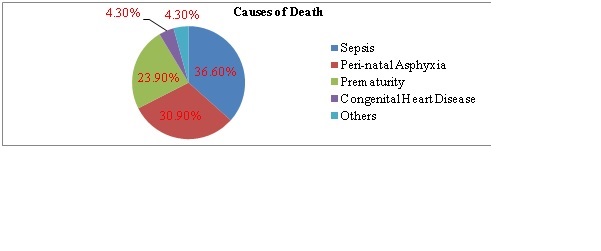Neonatal mortality trends at tertiary care hospital, Kuppam
Abstract
Background: Neonatal mortality rate is one of the indicators which depict the health care status of that country. Hospital based mortality and morbidity pattern helps in improving the quality of health care delivery in the hospital.
Objectives: (1) To determine the neonatal mortality trend over 36 months and various causes of neonatal mortality. (2) To determine the risk factors for early and late neonatal deaths.
Study Design: Retrospective study.
Study Population: Neonates admitted to Neonatal Intensive Care Unit (NICU).
Study Duration: From January 2015 to December 2017.
Methodology: Systematically and retrospectively charts were reviewed using data recorded in Neonatal Intensive Care Unit (NICU) at PESIMSR, Kuppam, Andhra Pradesh.
Results: A total of 2089 neonates were admitted to Neonatal Intensive Care Unit (NICU) between January 2015 to December 2017. Average Neonatal Mortality Rate (NMR) between January2015 to December 2017 was 7.5%. Early neonatal deaths were 35(49.3%) and Late Neonatal death was 36(50.7%). Common causes of death were neonatal sepsis, perinatal asphyxia and prematurity and its complications.
Conclusions: Implementing appropriate strategies to improve antenatal, perinatal and neonatal care helps in preventing perinatal asphyxia, neonatal sepsis and prematurity and its complications, which further helps in reduction of neonatal mortality, in-turn decreases the infant mortality and under 5 mortality rate.
Downloads
References
2. Oestergaard MZ, Inoue M, Yoshida S et al. Neonatal mortality levels for 193 countries in 2009 with trends since 1990: a systematic analysisof progress, projections, and priorities. PLoS Med. 2011 Aug;8(8):e1001080. doi: 10.1371/journal.pmed.1001080. Epub 2011 Aug 30.
3. Awofeso N, Rammohan A. Reducing Under-Five Mortality in India – A Review of Major Encumbrances and Suggestions for Progress. J Community Med Health Edu 2012; 2:116. doi:10.4172/2161-0711.1000116
4. ICMR Young Infant Study Group. Age profile of neonatal deaths. Indian Pediatr. 2008 Dec;45(12):991-4.[pubmed]
5. Rammohan A, Iqbal K, Awofeso N. Reducing neonatal mortality in India: critical role of access to emergency obstetric care. PLoS One. 2013;8(3):e57244. doi: 10.1371/journal.pone.0057244. Epub 2013 Mar 27.[pubmed]
6. Committee on fetus and new born, American Academy Of Pediatrics and committee on Obstetric Practice, American College Of Obstetrics and Gynecology. Use and abuse of the APGAR score. Pediatr1996;98:141-142.[pubmed]
7. Sarnat HB, Sarnat MS. Neonatal encephalopathy following fetal distress. A clinical and electroencephalographic study. Arch Neurol. 1976 Oct;33(10):696-705.[pubmed]
8. Lawn JE, Kinney MV, Black RE, et al. Newborn survival: a multi-country analysis of a decade of change. Health Policy Plan. 2012 Jul;27 Suppl 3:iii6-28. doi: 10.1093/heapol/czs053.[pubmed]
9. NITI Aayog,[updated 2017 Jan 21; cited on 2018 Sept 20] http://niti.gov.in/content/neo-natal-mortality-rate-nmr-1000-live-births.
10. Elhassan EM, Hassanb AA, Mirghani OA, Adam I: Morbidity and mortality pattern of neonates admitted into nursery unit in Wad Medani Hospital, Sudan. Sudan J Med Science 2010; 5(1):1316. Available from: http://dx.doi.org/10.4314/sjms.v5i1.56023
11. Patil R, Koppad R, Benakanal S. Clinical Profile and outcome of babies admitted to neonatal intensive care unit (NICU), Mc Gann Teaching Hospital Shivamogga, Karnataka: A Longitudinal Study. Sch. J. App. Med. Sci.2014; 2(6G): 3357-3360.
12. Mani Kant, Thakur S, Singh B. Study of the Morbidity and the Mortality Patterns in the Neonatal Intensive Care Unit at a Tertiary care teaching Hospital in Rohtas District, Bihar, India. Journal Of Clinical and Diagnostic Research. 2012 April ; 6(2): 282-285. doi: JCDR/3687:1994.
13. Bucens IK, Reid A, Barreto AC, et al. Three years of paediatric morbidity and mortality at the National Hospital in Dili, East Timor. J Paediatr Child Health. 2013 Dec;49(12):1004-9. doi: 10.1111/jpc.12305. Epub 2013 Jul 8.
14. Klaauw, Bas van der, Limin Wang. Child mortality in rural India, J Popul Econ 2011;24:601–628.doi10.1007/s00148-009-0290-3
15. National Family Health Survey, India. Available from: http://rchips.org/nfhs/factsheet_NFHS-4.shtml. (cited on 20/09/2018)

Copyright (c) 2018 Author (s). Published by Siddharth Health Research and Social Welfare Society

This work is licensed under a Creative Commons Attribution 4.0 International License.


 OAI - Open Archives Initiative
OAI - Open Archives Initiative


